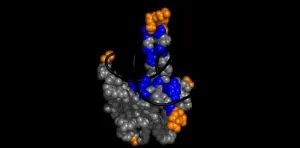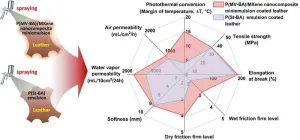(Press-News.org) #FRANKFURT. Immediately after the infection of a cell in the throat or lungs, the SARS-CoV-2 virus works very hard to replicate, using the human cell’s metabolic pathways to produce its proteins and make sure that its genetic material (the RNA genome) is copied. The RNA genome is then packaged very compactly into new virus particles that are released from the cell to infect more cells.
One viral protein, called the nucleocapsid protein (N), is particularly important for rapid and efficient replication. It wraps around the RNA genome in the virus and ensures that the very long RNA is tightly coiled up. When it penetrates the cell, N detaches itself from the RNA genome and assumes a whole range of functions during viral replication: When the RNA is translated into viral proteins, N protects the RNA from being destroyed by the cell’s antiviral defense mechanism (“RNA interference”). N also contributes directly to the transcription of RNA into viral proteins, and finally it collects the replicated viral RNA in the cell and coils it up so that new viral particles can form.
Like a Swiss army knife, N has several tools at its disposal for all these functions: Firstly, N must be able to distinguish between cellular and viral RNA and to coil up the latter in a spiral shape. That is why N can bind viral RNA in a relatively non-specific manner. To steer the transcription of viral RNA into viral proteins (translation), for example, N must, however, equally be able to recognize specific positions on the viral RNA, called RNA motifs.
Researchers led by Dr. Sophie Korn and Dr. Andreas Schlundt from the Institute for Molecular Biosciences and the Center for Biomolecular Magnetic Resonance (BMRZ) at Goethe University Frankfurt have now shed light on exactly how this specific binding through one of N’s tools, known as the N-terminal domain (NTD), works. Their results build on preliminary studies by the COVID19-NMR consortium established in Frankfurt during the pandemic. In the work now presented, Korn and her colleagues used nuclear magnetic resonance (NMR) spectroscopy, in which the atoms of the NTD tool and of the bound RNA are exposed to a strong magnetic field and in this way reveal something about their spatial arrangement during binding. In addition, a special X-ray technique (small-angle X-ray scattering, SAXS) delivered precise information about the stability of the newly formed molecular complexes.
The result: Both the sequence of the RNA building blocks (bases) and the spatial folding of the RNA are important for binding, whereby the positively charged part of the NTD binds the negatively charged RNA in a very unspecific way. Several “fingers” of the NTD then explore the RNA in search of motifs that the NTD can use to bind more stably. What attracted the researchers’ attention was that the NTD prefers motifs which are present in lung cells at body temperature in a specific spatial folding that is lost when the temperature increases by just a few degrees. This not only identifies them as their own target motifs but also binds them much more tightly, which could lead to the NTD exercising new functions.
Sophie Korn says: “Although our data are only a first step, they suggest that the virus could switch between replication and packaging into new virus particles in this way: At normal body temperature, the cell predominantly produces building blocks for new viruses. If we develop a fever in the course of the infection because our immune system recognizes and fights the virus, the virus might switch to replication as a direct result and ensure that the viral RNA is packaged more and released in the form of new virus particles. It is the viral RNA motifs themselves that provide the switch, which is then triggered by the human defense system.”
Andreas Schlundt is convinced: “With the combination of NMR spectroscopy and SAXS, we have established an experimental method that we can use to quickly assess which binding partners N prefers, and this can probably be transposed to other viral proteins. This will be useful both in the study of emerging viruses and viral variants as well as in the development of antiviral drugs that systematically disable the virus, minimizing side effects in the process.”
Background Information:
COVID19-NMR consortium
https://covid19-nmr.de/
Potential drugs against SARS-CoV-2 could directly attack the viral genome (2021)
https://aktuelles.uni-frankfurt.de/english/sars-cov-2-achilles-heel-of-viral-rna/
Folding of SARS-CoV-2 genome shows points of attack for drugs (2020)
https://aktuelles.uni-frankfurt.de/english/folding-of-sars-cov2-genome-reveals-drug-targets-and-preparation-for-sars-cov3/
END
SARS-CoV-2: The grasping fingers of the viral N protein
Researchers from Goethe University Frankfurt shed light on a pivotal part in the RNA-binding mechanism of the nucleocapsid protein (N) – SARS-CoV-2 probably uses human body temperature for its proliferation strategy
2023-08-21
ELSE PRESS RELEASES FROM THIS DATE:
Climate win-win: study quantifies benefits of enhanced weathering
2023-08-21
Applying ground-up silicate rock to Midwestern farm fields can capture significant amounts of carbon dioxide and prevent it from accumulating in the atmosphere, according to a new study that successfully quantified those climate benefits for the first time.
Working with Eion Corp., researchers at the University of Illinois Urbana-Champaign and the Leverhulme Centre for Climate Change Mitigation (LC3M) developed a new method to calculate the CO2-reduction potential of basalt rock amendments applied to cropland soil, a process known as enhanced weathering.
Traditional row-crop agriculture releases sizable amounts of soil-derived carbon to the atmosphere as CO2, a greenhouse gas ...
Late mortality after COVID-19 infection in veterans vs risk-matched comparators
2023-08-21
About The Study: The findings of this study indicate that COVID-19 was not associated with any clinically significant excess mortality among those who survived at least 180 days compared with closely risk-matched comparators, despite having worse 2-year total mortality. This finding has individual level and health system planning implications and should be reassuring to persons who have survived COVID-19 for at least 180 days.
Authors: Theodore J. Iwashyna, M.D., Ph.D., of the Ann Arbor VA in Ann Arbor, Michigan, is the corresponding author.
To access the embargoed study: Visit our For The Media ...
Screen time at age 1 and communication, problem-solving developmental delay at ages 2 and 4
2023-08-21
About The Study: In this study including 7,097 mother-child pairs, greater screen time for children at age 1 was associated with developmental delays in communication and problem-solving at ages 2 and 4. These findings suggest that domains of developmental delay should be considered separately in future discussions on screen time and child development.
Authors: Taku Obara, Ph.D., of Tohoku University in Sendai, Japan, is the corresponding author.
To access the embargoed study: Visit our For The Media website at this ...
International pediatric COVID-19 severity over the course of the pandemic
2023-08-21
About The Study: This study including 31,000 hospitalized children with SARS-CoV-2 infection suggested that while intensive care unit admission decreased over the course of the pandemic in all age groups, ventilatory and oxygen support did not decrease over time in children younger than age 5. These findings highlight the importance of considering different pediatric age groups when assessing disease severity in COVID-19.
Authors: Kirsty Short, Ph.D., of the University of Queensland in Brisbane, Australia, is the corresponding author.
To access the embargoed study: Visit our For The Media website at this link https://media.jamanetwork.com/
(doi:10.1001/jamapediatrics.2023.3117)
Editor’s ...
Websites selling direct-to-consumer Anti-Mullerian Hormone Tests
2023-08-21
About The Study: In this study including content analysis of 27 websites across multiple countries, most websites selling direct-to-consumer Anti-Mullerian Hormone (AMH) tests included false and misleading claims which might lead consumers to purchase an AMH test in the belief that it can reliably predict fertility potential and age of menopause. Depending on the test result, this may in turn lead to misplaced anxiety or reassurance about one’s fertility and modifications to subsequent conception or contraceptive plans and behavior.
Authors: Tessa Copp, Ph.D., of the University of Sydney in Sydney, Australia, is the ...
Artificial intelligence beyond the clinic
2023-08-21
With the advent of ChatGPT4, the use of artificial intelligence in medicine has absorbed the public’s attention, dominated news headlines, and sparked vigorous debates about the promise and peril of medical AI.
But the potential of AI reaches far beyond the frontlines of medicine.
AI is already changing the way scientists discover and design drugs. It is predicting how molecules interact and proteins fold with never-before-seen speed and accuracy. One day, AI may even be used routinely to safeguard the function of nuclear reactors.
These are but a few of the exciting applications of AI in the natural sciences, ...
Bio-based waterborne poly(vanillin-butyl acrylate)/mxene coatings for leather with desired warmth retention and antibacterial properties
2023-08-21
A study published in the journal of Engineering reveals a remarkable development in the field of green coating materials for leather. Researchers have successfully synthesized a solvent-free, bio-based antibacterial agent and aromatic monomer called methacrylated vanillin (MV). This innovative compound not only imparts antibacterial properties to leather coatings but also serves as an eco-friendly alternative to the petroleum-based carcinogen styrene (St).
In this research article, titled "Bio-based ...
Genetic study shows that common medication used to prevent heart attacks may be ineffective for majority of British South Asians
2023-08-21
Clopidogrel is a commonly prescribed medication used to prevent further heart attacks after an initial event. It needs to be activated in the body to be effective. Studies of European populations show that 30% of individuals have genetic variants that reduce or prevent activation through the production of an enzyme called CYP2C19. People of South Asian ancestry have high rates of cardiovascular disease, but previous studies have not looked for these variants in UK South Asian populations or linked these variants with risk of recurrent heart attacks if prescribed clopidogrel in South Asian ancestry ...
Tracking species range shifts in a changing climate
2023-08-21
As our planet undergoes significant transformations due to climate change, habitats are being altered, appearing, disappearing, or changing in quality. Understanding the impact of these changes on the geographic distributions of species is of great significance. The shrinking ranges of protected organisms and the expanding ranges of noxious species, such as pests and pathogens, highlight the urgent need to monitor range movements precisely. However, this task poses challenges as the available observation time is often short compared to the pace of underlying population processes, making it difficult to distinguish between directional shifts and random fluctuations.
Addressing ...
Formerly depressed patients continue to focus on negative
2023-08-21
People who have recovered from a major depressive episode, when compared with individuals who have never experienced one, tend to spend more time processing negative information and less time processing positive information, putting them at risk for a relapse, according to research published by the American Psychological Association.
“Our findings suggest that people who have a history of depression spend more time processing negative information, such as sad faces, than positive information, such as happy faces, and that this difference is greater compared to healthy people with no history,” said lead author Alainna Wen, PhD, ...
LAST 30 PRESS RELEASES:
Breakthrough organic crystalline material repairs itself in extreme cold temperatures, unlocking new possibilities for space and deep-sea technologies
Scientists discover novel immune ‘traffic controller’ hijacked by virus
When tropical oceans were oxygen oases
Positive interactions dominate among marine microbes, six-year study reveals
Safeguarding the Winter Olympics-Paralympics against climate change
Most would recommend RSV immunizations for older and pregnant people
Donated blood has a shelf life. A new test tracks how it's aging
Stroke during pregnancy, postpartum associated with more illness, job status later
American Meteorological Society announces new executive director
People with “binge-watching addiction” are more likely to be lonely
Wild potato follows a path to domestication in the American Southwest
General climate advocacy ad campaign received more public engagement compared to more-tailored ad campaign promoting sustainable fashion
Medical LLMs may show real-world potential in identifying individuals with major depressive disorder using WhatsApp voice note recordings
Early translational study supports the role of high-dose inhaled nitric oxide as a potential antimicrobial therapy
AI can predict preemies’ path, Stanford Medicine-led study shows
A wild potato that changed the story of agriculture in the American Southwest
Cancer’s super-enhancers may set the map for DNA breaks and repair: A key clue to why tumors become aggressive and genetically unstable
Prehistoric tool made from elephant bone is the oldest discovered in Europe
Mineralized dental plaque from the Iron Age provides insight into the diet of the Scythians
Salty facts: takeaways have more salt than labels claim
When scientists build nanoscale architecture to solve textile and pharmaceutical industry challenges
Massive cloud with metallic winds discovered orbiting mystery object
Old diseases return as settlement pushes into the Amazon rainforest
Takeaways are used to reward and console – study
Velocity gradients key to explaining large-scale magnetic field structure
Bird retinas function without oxygen – solving a centuries-old biological mystery
Pregnancy- and abortion-related mortality in the US, 2018-2021
Global burden of violence against transgender and gender-diverse adults
Generative AI use and depressive symptoms among US adults
Antibiotic therapy for uncomplicated acute appendicitis
[Press-News.org] SARS-CoV-2: The grasping fingers of the viral N proteinResearchers from Goethe University Frankfurt shed light on a pivotal part in the RNA-binding mechanism of the nucleocapsid protein (N) – SARS-CoV-2 probably uses human body temperature for its proliferation strategy


